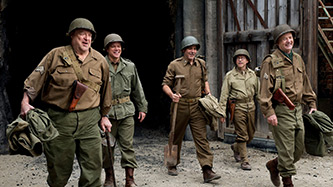Let’s start with the good news: you did your part. At least, I think you did your part. After all, it’s hard to tell if The Monuments Men was cast by you, or if it was a case of director, co-producer, and co-writer George Clooney simply choosing which buddies he wanted to hang out with for a few months. That may sound cynical, but I don’t mean it as a negative—the company he chooses to keep is full of actors I’m more than willing to spend a couple hours with. It’s just that, after all is said and done, his choice of good-time pals was the most amount of thought he put into the film.
It’s not fun for me to think like this. I really wanted to like The Monuments Men. After more than a decade of verité-obsessed World War II films that took their mark (and stole their style) from Saving Private Ryan, The Monuments Men’s retro style is pretty refreshing. And when Alexander Desplat’s score kicked the film off with a march reminiscent of Elmer Bernstein’s music for The Great Escape, I felt like I was returning to those simpler times when a war picture could be a grand adventure and not a test of my humanity. Sure, we might lose a few men along the way, but in the end it will all have been for a greater good. And that’s what really counts, right?
Heading up this escapade is Clooney’s character, Frank Stokes, who assembles a team of historians and artists to track down priceless works of art stolen by the Nazis, save them from destruction, and return them to their rightful owners. Matt Damon, Bill Murray, John Goodman, Bob Balaban, and Jean Dujardin all play members of the titular team. Like I said, those are all likeable actors, and each of them brings an easy-going charm to their roles. Cate Blanchett is solid, too, as a museum worker and French resistance fighter dedicated to keeping track of the stolen pieces that pass through her museum.
Clooney and co-writer Grant Heslov worked from the book by Robert M. Edsel and Ben Witter, and certainly want to structure The Monuments Men as a thrilling ride through war-torn Europe. They go out of their way to give Stokes a personal motivation for saving at least one specific piece of art, and then, on top of that, create two separate races against time: one involving Hitler’s order to destroy all stolen art before the allies can reclaim it, another involving the Russian Army claiming all found art as a restitution for their terrible losses. But these elements are introduced, forgotten, and then reintroduced only when the film needs to remind itself that something is supposed to be at stake. And with the exception of Blanchett, everyone member of the Monuments Men is so relaxed, so seemingly unaffected by their predicament, the threat never feels real. The cumulative effect of so much charm is that whenever events take turn for the serious, it feels too casual to be dramatic. It’s too bad, because Murray, playing architect Richard Campbell, has an especially nice scene involving a recorded Christmas message from his daughter. If only there was a better-constructed film around it to help it ring truer.
I wonder what it’s like for someone in your position to see a finished film like The Monuments Men. On paper, it should work. I wanted it to work. It’s hard to find so much fault with a film that means so well. You did what George asked of you—it’s just too bad George didn’t live up to his part of the bargain.
Wishing it was some other way,
Casey







